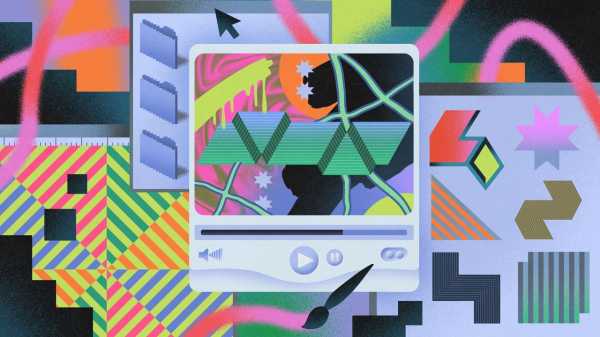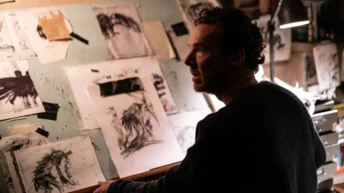
Save this storySave this storySave this storySave this story
In 2002, the thirty-five-year-old, Luxembourg-born painter Michel Majerus was on a short flight from Berlin, where he lived, to his native country, when the plane crashed, killing him and nineteen other passengers. With his death, a burgeoning artistic career was cut short. Majerus had been the subject of a solo museum exhibition in Switzerland, in 1996, and he’d created a major installation for the Venice Biennale, in 1999. There would be no more of his innovative œuvre, which included individual painted canvases in addition to room-scale installations smashing together the vocabulary of early digital culture—lo-fi video games, internet-y typefaces—with aggressive brushstrokes and flat planes of color borrowed from Abstract Expressionism and Minimalism. Majerus’s souped-up Apple PowerBook G3 laptop, however, survived the wreck—at least, the hard drive did.
The computer remained with his estate for many years, a relic left untouched. During that time, Majerus’s paintings continued to be shown in galleries and museums, exerting a quiet but persistent influence on a generation of artists who were creating work using and responding to the internet. Then, in 2017, the artist Cory Arcangel, famous for his digital art works, became aware of Majerus’s hard drive and began a quest to access its contents. What prompted Arcangel’s interest was an untitled painting of Majerus’s, from 2000, that an assistant had shown him on Instagram. The background is covered in acid-pastel blocks of color, reminiscent of the Neo-Geo movement of the nineteen-eighties, but the foreground contains evocative phrases in text that looks pulled from Geocities or a “Matrix”-era rave poster: “Newcomer,” “burned out,” “fuck the intention of the artist.” Majerus had intuited that the internet would lead to a great collision of styles and reference points—everything from Super Mario to Jackson Pollock coexisting in pixels. The untitled painting inspired nostalgia for the dial-up millennial generation, but Arcangel, whose own work includes a hacked version of “Super Mario Bros.” with only its clouds remaining, was also struck by how contemporary it seemed. During a recent Google Meet call from an austere apartment that a gallery representing the Majerus Estate maintains in Berlin, Arcangel said, “It just came at me from a hundred different angles, and each one of these little things sent me off into a spiral of associations.”
Given Majerus’s incorporation of digital imagery, such as video-game sprites, and the fluency of his tech-culture references, Arcangel guessed that Majerus was as much a digital artist as an analog painter. Perhaps the laptop held the key to his process. Arcangel brought the hard drive to the attention of Dragan Espenschied, the preservation director at Rhizome, a New York institution that archives the history of art created in digital environments. There was a risk that the hardware might malfunction and the stored files would be lost forever. The Majerus Estate commissioned a data rescue company to create a digital copy of the drive. Then, Espenschied used an emulator—a piece of software that mimics the entire architecture of an older device—to boot up a facsimile of the laptop, including its early-two-thousands operating system and the pixellated file icons on Majerus’s cluttered desktop, which featured a background image from Ms. Pac-Man. This was his computer exactly as he had left it, down to his customized Photoshop shortcuts and the positions of the windows. “It’s like he just stepped out of the room,” Arcangel said.
The contents of the computer revealed Majerus to be an artist who was “aggressively digital-native,” Arcangel said. From the files, Arcangel could reconstruct how Majerus had downloaded and collaged images of geometrically shaped Frank Stella paintings from the nineteen-sixties, zooming in, slicing them apart, and rotating them, then using them as the basis for his own wall-size, triangular “pressure groups” paintings, from 2002. Majerus used Photoshop to design his paintings and then virtually install them in specific gallery spaces in advance, tailoring the layout down to the inch, before his brush ever touched canvas. Arcangel has described Majerus as a kind of robotic “printer,” making all his decisions in advance and then rendering the output by hand.
The laptop also contained poignant artifacts of Majerus’s life: a photo of what appears to be a tiny New York City hotel room, with the artist’s chunky black laptop on the hotel bed alongside a bulky power adapter, a pizza box, candy, and a binder of compact disks, a television blaring in the background. What emerges is a portrait of the artist as an itinerant hacker, and a snapshot of digital creation in the years before social media or the advent of the cloud. “There’s only a few years where somebody would have carried around their whole studio with them,” Arcangel said.
Arcangel, who is forty-six, has a background in music composition but transitioned into visual art in the two-thousands, using a laptop similar to Majerus’s to create his early work. As Arcangel explored Majerus’s computer, he found himself remembering reflexively how to navigate the vintage software. The digital tools are part of the legacy of Majerus’s work—his art makes viewers recall what it was like to use the Photoshop paint bucket or burn a CD, back when those were radical technological experiences. Arcangel began recording a series of YouTube videos titled “Let’s Play Majerus G3,” riffing on the genre of Twitch-stream videos that capture creators playing video games. Last weekend in Berlin, Arcangel performed an iteration of “Let’s Play Majerus G3” at the Majerus Estate for an audience of a hundred gallerygoers, talking through the artist’s desktop and pulling up his favorite files. They included one of the only existing videos of Majerus painting, and a Photoshop image in which the artist had made a digital sketch, then edited that sketch into a photograph of his studio, visualizing what it would be like if the digital image were a canvas leaning against the wall, as if it were a physical work-in-progress. In this way, Arcangel explained, Majerus seemed to merge his computer and his IRL studio into one creative space.
Digital art has thus far not proved to be particularly durable. There are now more than two decades’ worth of experimental websites, art projects on defunct social networks, and vernacular digital images that have simply been lost to technological obsolescence and disuse. Majerus’s laptop, and Arcangel’s archival work and performances, represent an effort to insert the visual legacy of our era into the longer arc of art history, to immortalize the ephemeral modus vivendi of a particular technological moment. On our video chat, Arcangel pulled up another collage in which Majerus had placed images of his work next to photos of vintage Stella exhibitions, installations of the Neo-Geo painter Peter Halley’s work, and a more recent Stella painting that Majerus had encountered in a Manhattan skyscraper lobby. He was measuring his own accomplishments against those of his influences, merging art-historical references with his own output across time, on his super-powered laptop. Majerus’s art work was birthed on the screen, and through his recovered files, Arcangel said, “We get to see over the shoulder of one of the best artists to ever do it.” ♦
Sourse: newyorker.com







